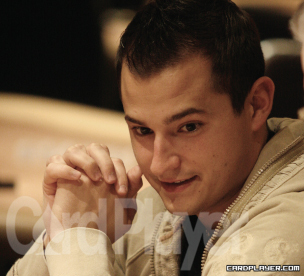






Run It Twice -- Matt GiannettiGiannetti Walks Us Through a No-Limit Hold'em Hand |
|
|
 Matt Giannetti is a 24-year-old professional poker player who lives in Las Vegas. Since turning pro, he has been consistently beating high-stakes no-limit hold'em cash games both online and live. He sat down with Card Player to discuss a hand he played at Bellagio.
Matt Giannetti is a 24-year-old professional poker player who lives in Las Vegas. Since turning pro, he has been consistently beating high-stakes no-limit hold'em cash games both online and live. He sat down with Card Player to discuss a hand he played at Bellagio.
The Game
Key Concepts:
Run it Twice -- Review of the Hand
Preflop Action: The under-the-gun player straddles for $100. Six players limp, including the small blind. Matt Giannetti has pocket aces in the big blind. He calls the $100 straddle. The straddler gets last option and raises to $800. Two limpers call. Giannetti reraises to $4,600. The straddler folds, and the first limper who called the straddler's raise calls. The other limper who called the raise folds. It's now heads up to the flop.
Kristy Arnett: How was the table playing before this hand came up?
Matt Giannetti: It was an extremely aggressive $25-$50 [no-limit hold’em] game. There was a guy who had taken a very bad beat, and he was steaming. He started opening every single pot for like $500, which for this game is obviously a lot.
KA: So, he is definitely affecting the dynamic of the table. What goes into your decision-making when looking down at pocket aces in the big blind?
MG: Knowing that the aggressor in the straddle is still steaming, I feel like he’s for sure going to raise if everyone limps in, so I decided to gamble and just called the $50 more. Just as I thought, he raised it up to $800 to go. He got called in two spots, then it came back to me. I knew it looked suspicious that I would actually have a hand in this spot, so I reraised it up.
Flop Action: The flop came 10-6-4 rainbow. Giannetti checked, and his opponent bet $6,400. Giannetti check-raised to $14,000. His opponent went all in, and he called.
KA: How did you take what you already knew about this player into consideration when making your decision on how to proceed post-flop?
MG: What I know about my opponent is that he is one of the most aggressive players I’ve ever played with. If he had pocket tens or sixes, he would have raised preflop. Pocket fours is a possibility, but I’m not that concerned with that hand. If I check to him, he will probably put me on A-K and bet. So, instead of betting out here, I checked to him to get his added bluff every time he doesn’t have pocket fours, and if he does have pocket fours, I’m kind of willing to lose my money just because of how aggressive he is. So, I check, and he bets $6,400. My stack size was around $27,000 at this point. I’m really confident in my hand, and I made it $14,000 to go.
KA: Why did you decide on this bet size?
MG: That was a really small raise, but what it did was it left me with about $13,000 behind. I wanted him to think that there was still a possibility that he could get me off my hand. He’s played with me before, and he knows that I sometimes make raises that look really strong, but aren’t really. But this time, I was making a raise that looked strong, but to him, might not seem strong, but really was strong [laughs]. There is all kinds of leveling going on here. He did put me all in, and I insta-called. He did exactly what I wanted him to do throughout the hand. He had Q-10.
Outcome:
MG: We ran it twice, and he ended up winning both times. It was sick. He had a five-outer with two cards to go, hit, and when we ran it the second time, he had a four-outer with two cards to go. Oh well, it happens [laugh]. But by analyzing table images and using bet-sizing, I got him to do what I wanted him to do, even though it didn’t turn out the best.
Also, part of being a good player is knowing when to get up off the table. I got up after that hand.
